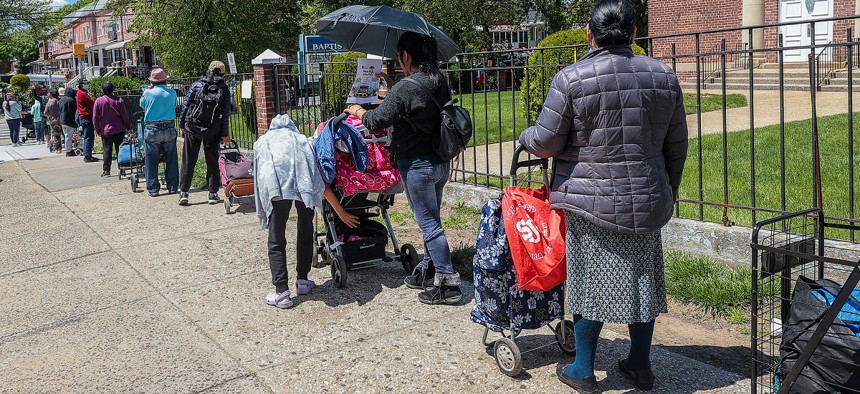Nonprofits
Report: Poverty in NYC jumps to 23%
An increase of 7 percentage points from the previous year was noted in the sixth Poverty Tracker Annual Report released by Robin Hood and Columbia University’s Center on Poverty and Social Policy.

People, facing food insecurity, wait in line to get meals served by the nonprofit Queens Together, representing local restaurants from the borough, on May 06, 2023. (Photo by Selcuk Acar/Anadolu Agency via Getty Images)
Poverty in New York City increased from 18% in 2021 to 23% in 2022, according to a newly released report by Robin Hood and Columbia University’s Center on Poverty and Social Policy. The sixth Poverty Tracker Annual Report found that the number of people living in poverty grew from 1.5 million to 2 million between 2021 - 2022, leaving New York City to have nearly double the national average rate (12%).
In 2022, rents in New York City were among the highest in the country, according to the City Comptroller’s Office. New Yorkers were hit by the increased cost of living in the city, including but not limited to rent, food, and transportation. Eight out of the ten neighborhoods with the highest eviction rates from 2020 - 2022 were in the Bronx, according to data from the Comptroller. These neighborhoods are majority low-income and of color. The Census estimates that the percentage of Bronx residents in poverty is around 27.6%--the highest in the city.
The poverty tracker found that 1 in 5 low-income New Yorkers were living paycheck-to-paycheck. For a renting household with two adults and two children in New York City, the poverty line is $43,890. This figure determines what is needed to afford the minimal basic standard of living, however, it does not mean that the family is thriving. 2022 saw a huge increase in the rate of poverty amongst children. The poverty tracker reports that the rate of poverty for children had a dramatic increase from 15% to 25%. It is the highest the tracker has reported since 2015. It is double the rate of poverty nationally for children, with the average number being 12%.
New York City residents faced material hardship. Roughly 3 in 10 adults in New York City faced one form of material hardship (food, housing, bills, financial, or medical) and 1 in 10 faced multiple. The highest rate of hardship faced by adults in the city were related to medical circumstances. For children, it was financial.
The Coalition for the Homeless says that 92,824 homeless people were sleeping in New York City's shelter system in November 2023, including 33,365 children. For families, the largest reason for homelessness is lack of affordable housing. The Poverty tracker claims that they found that government policy effectively fights poverty. Robin Hood and Columbia University in a released statement about the report stated that establishing and increasing the supply of the Housing Access Voucher Program (HVAP) could serve around 14,000 households statewide.
“We know that fully refundable tax credits, housing vouchers, and childcare subsidies can move millions out of poverty and hardship. But we have lacked the will to keep these policies in force,” Richard R. Buery Jr., CEO of Robin Hood, said in the statement. “We are calling on lawmakers to make investments that will help our neighbors live lives of opportunity.”

NEXT STORY: New York City’s budget outlook is great/terrible depending which watchdog you ask.

